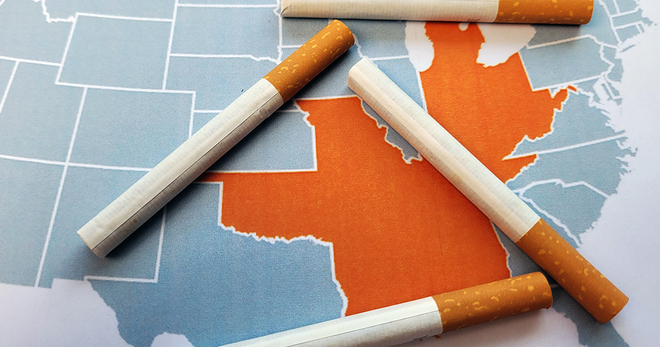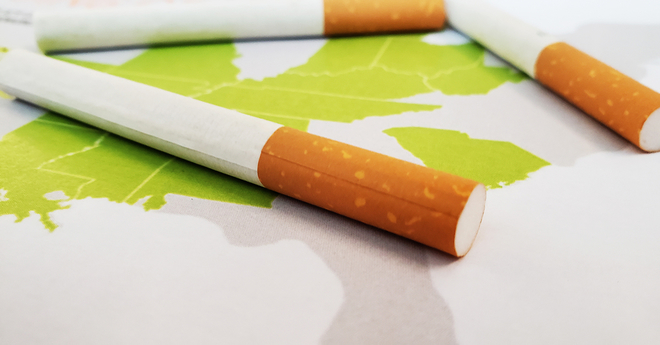Tobacco use in California 2021
Cigarette use: California*
Cigarette smoking rates in California
- In 2020, 8.9% of adults smoked. Nationally, the rate was 15.5%.1
- In 2017, 5.4% of high school students in California smoked cigarettes on at least one day in the past 30 days. Nationally, the rate was 8.8% in 2017.2
Other tobacco product use: California
Vaping rates in California
- In 2017, 3.0% of adults in California used e-cigarettes.3
- In 2020, 1.8% of adults in California used smokeless tobacco.3
- In 2019, 18.2% of high school students in California used electronic vapor products on at least one day in the past 30 days. Nationally, the rate was 32.7%.4
- In 2019, 7.6% of high school students in California used chewing tobacco, snuff or dip on at least one day in the past 30 days. Nationally, the rate was 3.8%.4
Economics of tobacco use and tobacco control
California cigarette tax
- California received $2.82 billion (estimated) in revenue from tobacco settlement payments and taxes in fiscal year 2021.5
- Of this, the state allocated $233.1 million in state funds to tobacco prevention in fiscal year 2020, 67% of the Centers for Disease Control and Prevention’s annual spending target.5
- Smoking-related health care costs: $13.29 billion per year.5
- Smoking-related losses in productivity: $10.35 billion per year.6
California tobacco laws
California smoking laws
Tobacco taxes
- California is ranked 13th in the U.S. for its cigarette tax of $2.87 per pack (enacted April 2017), compared with the national average of $1.91. (The District of Columbia has the highest tax at $4.50 and Missouri has the lowest at 17 cents.) 7-9
- All other tobacco products are taxed at 65.08% of the wholesale price.7,8
Clean indoor air ordinances
- Smoking is prohibited in all government and private workplaces, public schools, restaurants, bars, casinos/gaming establishments (tribal establishments exempt), retail stores, recreational/cultural facilities and childcare facilities.8
- E-cigarettes are included in the state’s clean indoor air law.10
Licensing laws
- Retailers, wholesalers, and distributors are required to obtain a license to sell tobacco products.7
- Retailers, wholesalers, and distributors are required to obtain a license to sell e-cigarette products.10
Youth access laws
- Effective December 2019, the United States adopted a law raising the federal minimum age of sale of all tobacco products to 21. Some states have not yet raised their state minimum age of sale, however, the federal law takes precedence.
- Establishments are required to post signs stating that sales to underage consumers are prohibited.10
- Self-service displays of e-cigarettes are prohibited. 10
- Vending machine sales of e-cigarettes must be located inside a bar at least 15 feet from the entrance. 10
- Sale of flavored e-cigarettes and flavor enhancers are prohibited (except for certain hookah businesses). 10
- The possession or use of e-cigarettes by wards and inmates of all institutions and camps under the jurisdiction of the Department of the Youth Authority is prohibited. 10
- Delivery sales, distribution, or nonsale distribution, such as mail, phone, online, of e-cigarettes through the U.S. Postal Service or any other public or private postal service is prohibited unless the age of the product purchaser is verified as 21 years or older at both time of purchase and delivery. Additionally, the container must be conspicuously labeled with “CONTAINS TOBACCO PRODUCTS: SIGNATURE OF PERSON 21 YEARS OF AGE OR OLDER REQUIRED FOR DELIVERY.” 10
Baseball stadium laws
- The use of smokeless tobacco is prohibited in California’s five professional baseball stadiums.7
Local tobacco laws
- Beverly Hills prohibits the sale of all tobacco products in the city; cigar lounges are exempt and guests in the city’s luxury hotels can acquire cigarettes through their concierge or room service. Manhattan Beach prohibits the sale of all tobacco products in the city.11
- 74 localities, including Alameda County, Contra Costa County, Long Beach, Los Angeles County, Marin County, Oakland, Sacramento, San Francisco, San Mateo County, Santa Barbara County, Santa Clara County, Santa Cruz County, and Yolo County, prohibit the sale of all flavored tobacco products.11
- 27 other localities have varying restrictions on the sale of flavored tobacco products.11
- 31 localities have banned the sale of all e-cigarettes, with variances for those products that have received FDA premarket approval.11
- 42 localities have banned pharmacies from selling tobacco products, including Alameda County, Contra Costa County, Los Angeles County, Marin County, San Francisco, San Mateo County, Santa Clara County, and Sonoma County.12
- San Francisco caps the number of tobacco sales permits in each of the city’s 11 districts at 45, and new tobacco retailers are prohibited within 500 feet of any school or another retailer.13
Quitting statistics and benefits
Quitting vaping and smoking in California
- The CDC estimates 53.0% of daily adult smokers in California quit smoking for one or more days in 2019.3
- In 2014, the Affordable Care Act required that Medicaid programs cover all quit medications.8**
- California’s state quit line invests $3.04. per smoker, compared with the national average of $2.28.8
- California does not have a private insurance mandate provision for quitting tobacco.8
Notes and references
Updated August 2021
*National and state-level prevalence numbers reflect the most recent data available. This may differ across state fact sheets.
**The seven recommended quitting medications are NRT gum, NRT patch, NRT nasal spray, NRT inhaler, NRT lozenge, Varenicline (Chantix) and Bupropion (Zyban).
Fiore MC, et al. Treating Tobacco Use and Dependence: 2008 Update. Clinical Practice Guideline. Rockville, MD: US Department of Health and Human Services. Public Health Service: May 2008.
1. CDC, Behavioral Risk Factor Surveillance System, 2020.
2. CDC, Youth Risk Behavior Surveillance System, 2017.
3. CDC, Behavioral Risk Factor Surveillance System, State Tobacco Activities Tracking and Evaluation System, 2021.
4. CDC, Youth Risk Behavioral Surveillance System, 2019.
5. Campaign for Tobacco-Free Kids, Broken Promises to Our Children: a State-by-State Look at the 1998 State Tobacco Settlement 22 Years Later FY2021, 2020.
6. Campaign for Tobacco-Free Kids, Toll of Tobacco in the United States.
7. American Lung Association, State Legislated Actions on Tobacco Issues (SLATI).
8. American Lung Association, State of Tobacco Control, 2021.
9. Campaign for Tobacco-Free Kids. State Cigarette Excise Tax Rates & Rankings. https://www.tobaccofreekids.org/assets/factsheets/0097.pdf. Accessed.
10. Public Health Law Center. U.S. E-Cigarette Regulation: 50-State Review. http://www.publichealthlawcenter.org/resources/us-e-cigarette-regulations-50-state-review. Accessed.
11. Truth Initiative, Local restrictions on flavored tobacco and e-cigarette products. https://truthinitiative.org/research-resources/emerging-tobacco-products/local-restrictions-flavored-tobacco-and-e-cigarette.
12. Americans Nonsmokers' Rights Foundation. Municipalities with Tobacco-Free Pharmacy Laws. http://no-smoke.org/pdf/pharmacies.pdf. Accessed.
13. San Francisco Board of Supervisors. San Francisco Health Code Article 19H. http://www.sfbos.org/ftp/uploadedfiles/bdsupvrs/ordinances14/o0259-14.pdf. Published 2014. Accessed.
More in smoking by region
Want support quitting? Join EX Program
By clicking JOIN, you agree to the Terms, Text Message Terms and Privacy Policy.
Msg&Data rates may apply; msgs are automated.





